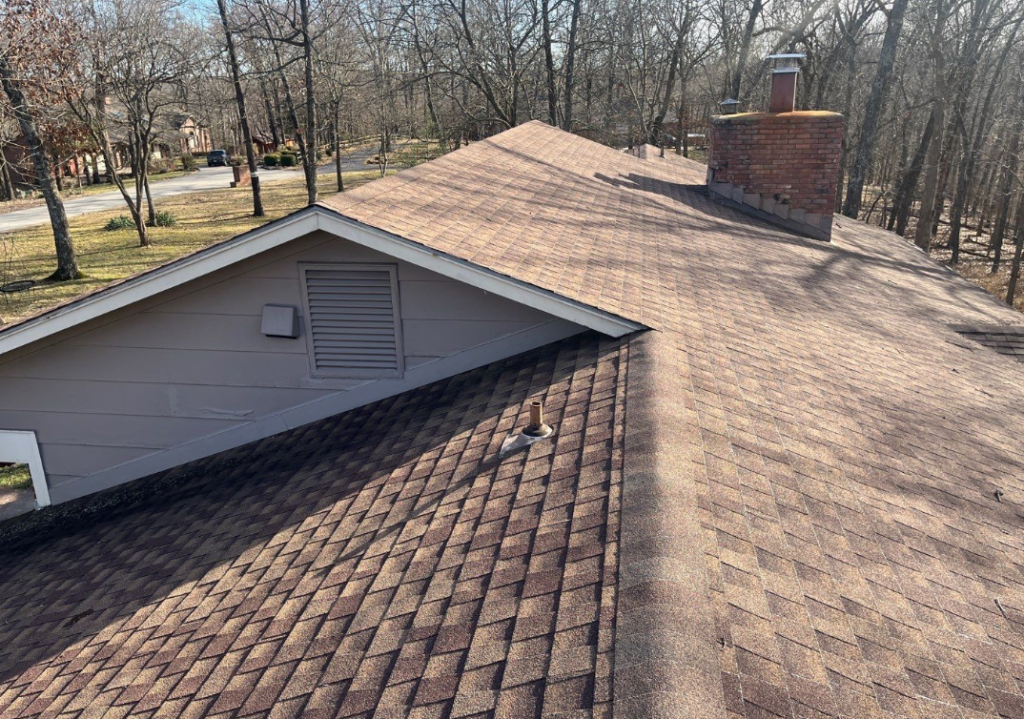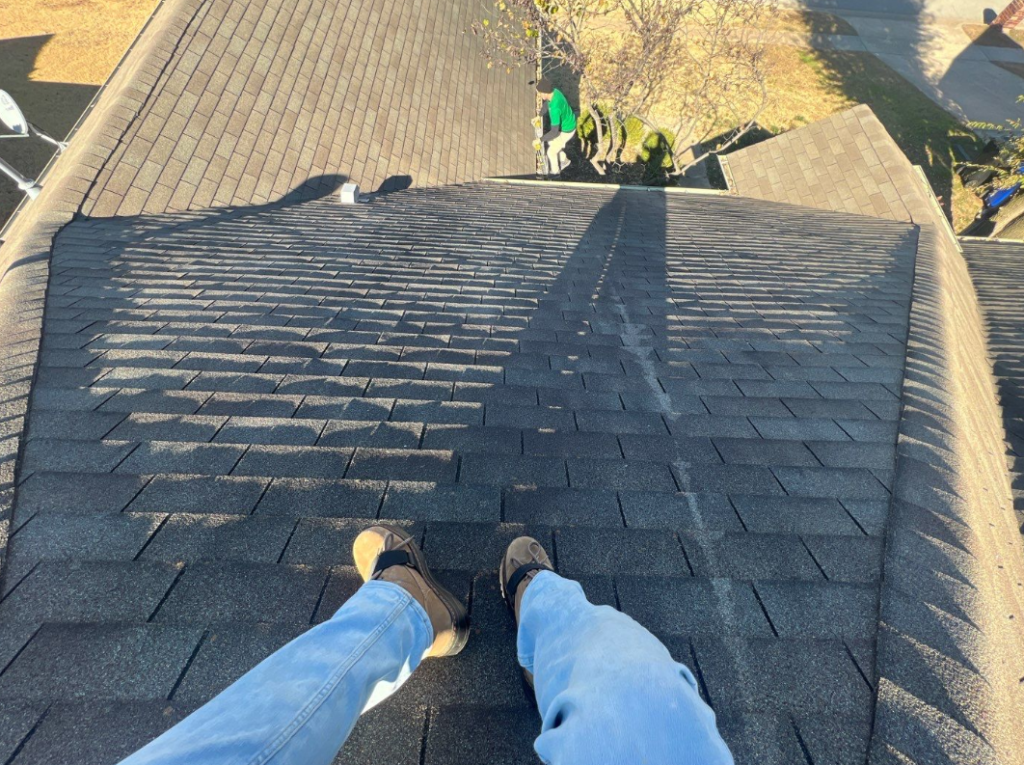Roof Replacement Vs Repair
When it comes to roof maintenance, homeowners often find themselves faced with the decision of whether to opt for a roof replacement or a repair. Each option has its merits, depending on various factors such as the age and condition of the roof, extent of the damage, and long-term plans for the home.
Making the right choice requires careful consideration and expert advice. So, before making any hasty decisions, let’s take a closer look at the key factors to weigh when deciding between roof replacement and repair.
The consequences of this decision can have a significant impact on the longevity, safety, and overall value of your home. Th team at Luck Roofing are the best roofing contractors in Arkansas, give us a call today for a free inspection and quote for your roofing project.
Key Takeaways
- Assessing the age and condition of the roof is crucial in determining whether repair or replacement is necessary.
- Evaluating the severity of the damage and considering the cost comparison between repair and replacement is important.
- Different types of roofs have varying lifespans and maintenance requirements.
- The urgency of the situation, future plans for the home, and potential energy efficiency benefits should be considered when deciding between repair and replacement.
Age Of The Roof
 When considering whether to replace or repair a roof, one important factor to assess is the age of the roof. The age of the roof plays a crucial role in determining the best course of action. A roof that is approaching the end of its lifespan may require preparation for a replacement, while a younger roof may be a candidate for repair.
When considering whether to replace or repair a roof, one important factor to assess is the age of the roof. The age of the roof plays a crucial role in determining the best course of action. A roof that is approaching the end of its lifespan may require preparation for a replacement, while a younger roof may be a candidate for repair.
Roofs typically have a lifespan of 20 to 25 years, although this can vary depending on factors such as the quality of materials used and the climate in which the roof is located. As a roof ages, it becomes more susceptible to damage from the elements, such as wind, rain, and snow. This can lead to leaks, missing shingles, or other signs of wear and tear.
Regular roof inspections are essential for assessing the condition of the roof and identifying any potential damage. A professional inspector can determine if the roof is still in good condition or if it is nearing the end of its lifespan. They can also identify any areas that may require repair or replacement.
If the roof is relatively young and only has minor damage, repair may be a viable option. However, if the roof is older and has significant damage, replacement may be the more cost-effective solution.
Extent Of The Damage
Assessing the extent of the damage is crucial in determining whether a roof repair or replacement is necessary. Here are three key factors to consider when evaluating the damage:
- Severity of the damage: Take a close look at the condition of your roof. Are there minor issues like a few missing shingles or small leaks? Or is the damage more extensive, such as widespread leaks or structural issues? Minor damage can often be repaired, but extensive damage may require a roof replacement.
- Cost comparison: While repairing a small area may seem more economical, extensive damage may cost almost as much as replacing the entire roof. Consider the long-term costs and benefits when making your decision.
- Potential for future damage: It’s important to consider the potential for future damage if only repairs are done. Water damage or wind getting under the roof can cause additional issues down the line. Consulting with a professional can help evaluate the extent of the damage and provide insights into potential future problems.
Assessing the extent of the damage is also crucial when filing an insurance claim. Insurance companies often require detailed documentation of the damage to determine whether a repair or replacement is necessary. Therefore, consulting with a professional and providing accurate information can help streamline the insurance claims process.
Roof Restoration Vs. Replacement-Which Option To Choose
Type Of Roof
 Different types of roofs have varying lifespans and maintenance requirements, making it essential to consider the type of roof when deciding between roof repair and replacement. The type of roof can greatly impact the cost, durability, and overall performance of your roofing system. Here is a comparison of some common roofing materials:
Different types of roofs have varying lifespans and maintenance requirements, making it essential to consider the type of roof when deciding between roof repair and replacement. The type of roof can greatly impact the cost, durability, and overall performance of your roofing system. Here is a comparison of some common roofing materials:
| Roofing Material | Lifespan | Maintenance Requirements |
|---|---|---|
| Asphalt Shingles | 20-30 years | Regular inspections and occasional repairs |
| Metal | 40-70 years | Minimal maintenance, occasional inspections |
| Tile | 50-100+ years | Regular inspections and repairs of cracked tiles |
| Slate | 75-200+ years | Minimal maintenance, occasional inspections |
Asphalt shingles are the most commonly used roofing material due to their affordability and ease of installation. They have a relatively shorter lifespan compared to other materials and may require regular inspections and occasional repairs. Metal roofs, on the other hand, have a longer lifespan and require minimal maintenance. Tile and slate roofs are known for their exceptional durability, with lifespans that can exceed a century. However, they may require regular inspections and repairs to address cracked or broken tiles.
When deciding between roof repair and replacement, it is important to consider the type of roof you have and its current condition. If you have an aging asphalt shingle roof that is nearing the end of its lifespan, it may be more cost-effective to opt for a roof replacement. However, if you have a relatively new roof with minor damage, a repair may be sufficient to extend its lifespan. Consulting with a professional can help you make an informed decision based on your specific situation and budget considerations.
Urgency
In determining whether to pursue roof repair or replacement, it is crucial to evaluate the urgency of the situation. Understanding the urgency will help you make an informed decision and prioritize the necessary actions.
Consider the following factors when deciding on the urgency of roof replacement or repair:
- Extent of Damage: Assess the severity of the damage to your roof. If the damage is extensive, such as multiple leaks or missing shingles, it may be a sign that a roof replacement is necessary. Minor damage, however, can often be resolved with repairs.
- Age of the Roof: Consider the age of your roof. If your roof is approaching the end of its lifespan, which is typically around 20 to 25 years, it may be more cost-effective to opt for a roof replacement instead of multiple repairs.
- Future Plans for the Home: Evaluate your future plans for the property. If you plan on selling the house in the near future, a new roof can significantly increase its value and curb appeal. However, if you plan on staying in the home for a longer period, repairs may be a more sensible choice to extend the life of your current roof.
Long-Term Plans
Considering the long-term implications and future prospects of your home, careful evaluation of various factors is essential when deciding between roof repair or replacement. Long-term plans involve considering the age of the roof, duration of stay in the home, current financial situation, condition of the roof, and potential for future problems. To help you make an informed decision, it is recommended to consult with a professional roofing contractor and schedule a free inspection.
When assessing the long-term plans for your roof, it is important to understand the lifespan of different roofing materials. This can guide you in determining whether a repair will be sufficient or if a full replacement is necessary. Here is a table summarizing the average lifespan of common roofing materials:
| Roofing Material | Lifespan |
|---|---|
| Asphalt Shingles | 20-30 years |
| Metal Roofing | 40-70 years |
| Cedar Shake | 20-40 years |
Energy Efficiency
Energy-efficient roofs can significantly reduce energy consumption and contribute to long-term cost savings. When considering whether to opt for roof replacement or repair, it is important to evaluate the potential energy efficiency benefits. Here are three key points to consider:
- Recover installation costs: Energy-efficient roofs may have a higher upfront cost compared to traditional roofing materials. However, they can help recover these costs over time through energy savings. With lower energy consumption, homeowners can expect reduced utility bills and long-term cost savings.
- Continuously improving materials: Roofing materials are constantly evolving, with advancements in energy efficiency. The latest roofing options are designed to enhance insulation and minimize heat transfer, resulting in lower energy usage for heating and cooling. By choosing an energy-efficient roof, homeowners can enjoy reduced energy bills and a more comfortable living space.
- Environmental impact: Roof replacement offers an opportunity to select eco-friendly roofing materials. These materials are often made from recycled or sustainable materials and have a lower environmental impact. By opting for environmentally friendly options, homeowners can contribute to a greener future while enjoying the energy-saving benefits.
Consulting with professionals in the roofing industry can provide valuable insights into the environmental and cost-saving benefits of energy-efficient roofing options. They can assess the age and type of the current roof, evaluate potential energy savings, and recommend the most suitable roofing solution for your needs.
Building Codes
Building codes play a crucial role in ensuring the safety, structural integrity, and environmental compliance of roofing installations and repairs. These regulations, set by local government authorities, dictate requirements for materials, design, construction techniques, and structural integrity. Adherence to building codes is essential to avoid potential legal issues and ensure that the roof replacement or repair meets the necessary standards.
For more information on building standards check out our article on Do You Need A Permit To Replace A Roof Arkansas
When it comes to roof replacement or repair, building codes affect the work that roofing contractors can undertake. For instance, local building codes may impact the feasibility of certain roofing methods, such as installing a metal roof over shingles. It is important to consult the local building codes before proceeding with any work to ensure compliance.
Building codes may also dictate the number of layers allowed in re-roofing, weight considerations, and other factors that need to be considered during roof replacement or repair. Failure to adhere to these codes can lead to complications with insurance claims. Insurance companies may require proof that the work was completed in compliance with building codes to provide coverage.
Roofing contractors should be knowledgeable about local building codes to ensure that the roof replacement or repair is done properly. They should be able to provide documentation and adhere to the necessary standards to avoid any legal or insurance issues. Following building codes helps to ensure the safety and longevity of the roof.
Budget
When evaluating roof replacement or repair options, one important factor to consider is the budgetary implications of each choice. Making the right decision requires assessing the costs involved and understanding the potential long-term financial impact.
Here are three key points to consider when it comes to budgeting for roof replacement or repair:
- Cost: Roof replacement generally carries a higher upfront cost compared to repairs. The average cost of a roof replacement ranges between $5,000 and $10,000, but can go up to $16,000 for larger or specialized projects. On the other hand, roof repairs can range from $300 to $1,000, depending on the extent of the damage. It’s important to carefully evaluate your budget and the extent of the damage before making a decision.
- Insurance Coverage: Check your homeowner’s insurance policy to determine if it covers roof repairs or replacements. Some policies may cover the cost of repairs if the damage is caused by a covered peril, such as a storm or fire. However, coverage for roof replacement may be limited to the depreciated value of the roof. Understanding your insurance coverage can help you make an informed decision while considering your budget.
- Long-term Savings: Although roof replacement may have a higher initial cost, it can save you money in the long run. Energy-efficient roofing materials can help reduce your energy bills over time, and more durable materials can prevent costly repairs or replacements in the future. Consider the potential long-term savings when evaluating the budgetary implications of roof replacement versus repair.
When it comes to roof replacement or repair, budgeting is a crucial aspect to consider. By carefully assessing the costs, insurance coverage, and long-term savings, you can make an informed decision that aligns with your budget and future plans for your home.
Consider the option of a Nail Over Reroof Vs. Roof Replacement
Bottom Line
In conclusion, when deciding between roof repair and replacement, it is important to carefully assess your budget, long-term plans for your home, and the extent of damage in order to make an informed decision. To help you evaluate the bottom line and choose the option that best suits your needs, consider the following factors:
| Factors | Roof Repair | Roof Replacement |
|---|---|---|
| Cost | Less expensive upfront | More expensive upfront |
| Lifespan | Extends the life of an older roof | Provides a new roof with a longer lifespan |
| Addressing Underlying Issues | May not address all underlying issues | Can address underlying issues and improve the roof’s performance |
| Curb Appeal | May not significantly improve curb appeal | Can significantly enhance the appearance of your home |
| Energy Efficiency | May not offer substantial energy savings | Can improve energy efficiency and lower utility bills |
While roof repair may be a more budget-friendly option in the short term, a full roof replacement can provide long-term benefits such as improved curb appeal, energy efficiency, and a longer lifespan. Additionally, a replacement may address underlying issues and prevent the need for future repairs. It is crucial to evaluate these factors and consult with a professional roofing company to determine the most suitable choice for your specific situation. By doing so, you can ensure that your decision aligns with your budget and long-term plans for your home.
Final Thoughts
In conclusion, when deciding between roof replacement and repair, homeowners should consider factors such as the age and condition of the roof, the extent of the damage, and their long-term plans for the home.
While roof replacement may require a larger upfront investment, it can provide a longer-lasting solution and potentially save money in the long run.
On the other hand, roof repair can help extend the life of an older roof and address specific issues.
Ultimately, consulting with a professional roofing contractor can help make an informed decision
Michael Overzat
Michael Overzat resides in Fort Smith, Arkansas with his wife and three kids. He enjoys to hike, skateboard, write, and get involved in charity organizations. He was originally born in Maryland. He has worked within the roofing industry for 5 years and is very active within the industry by attending conferences, masterminds, etc. His vision is to create a multi-state organization that has a customer centric model. He's worked for some of the biggest names in the industry and hopes to create a more people focused model for the roof replacement process.

